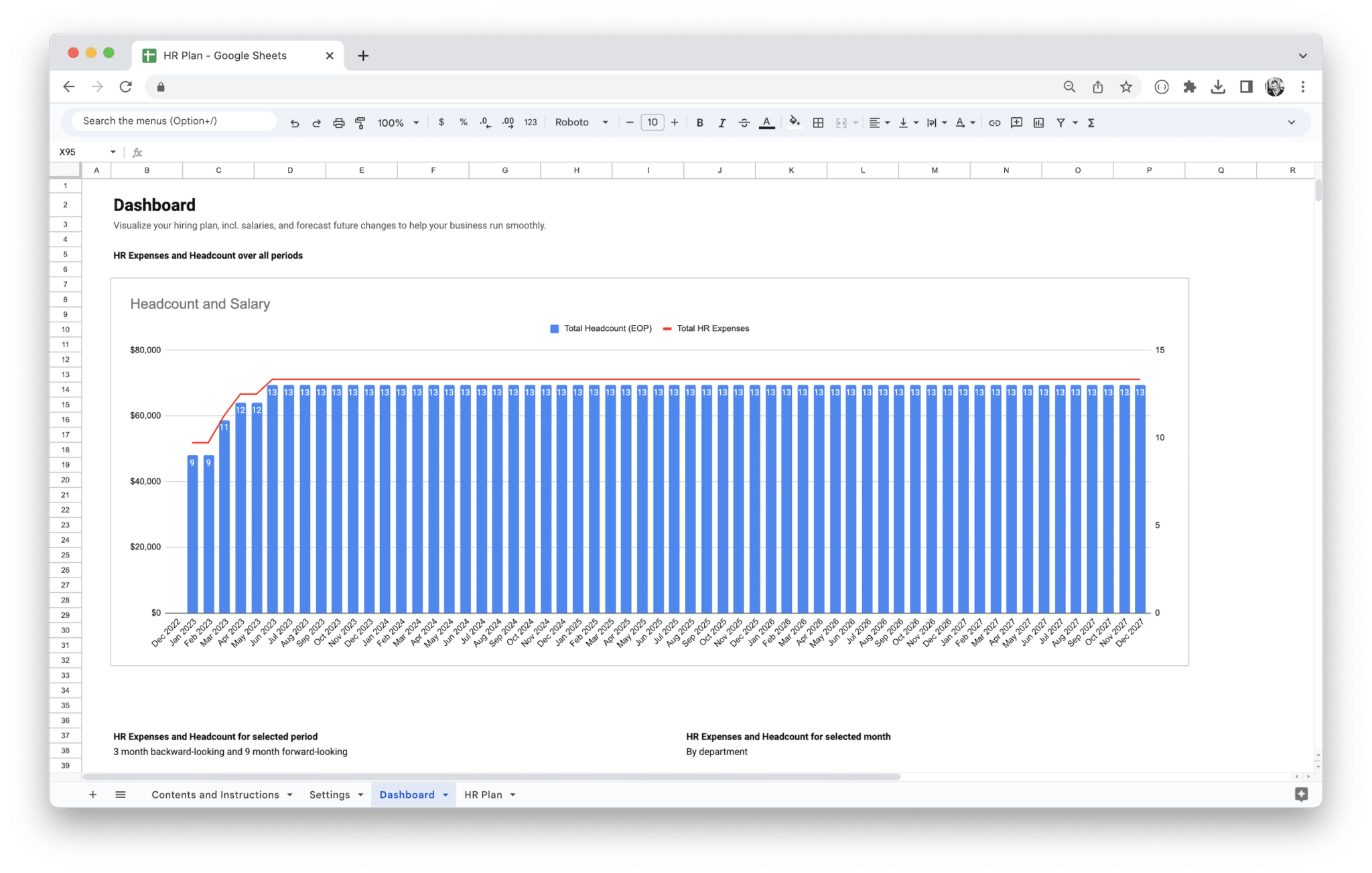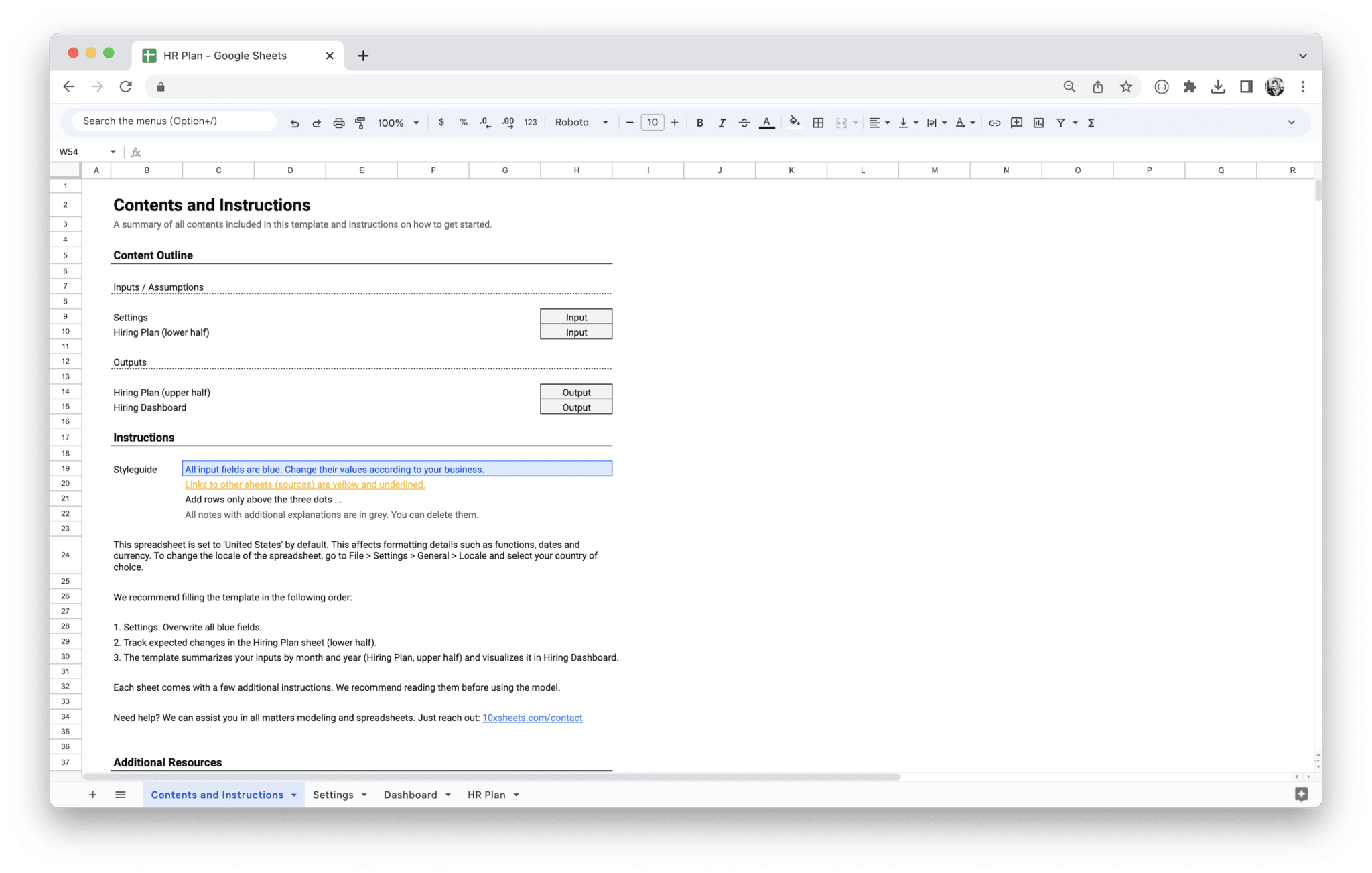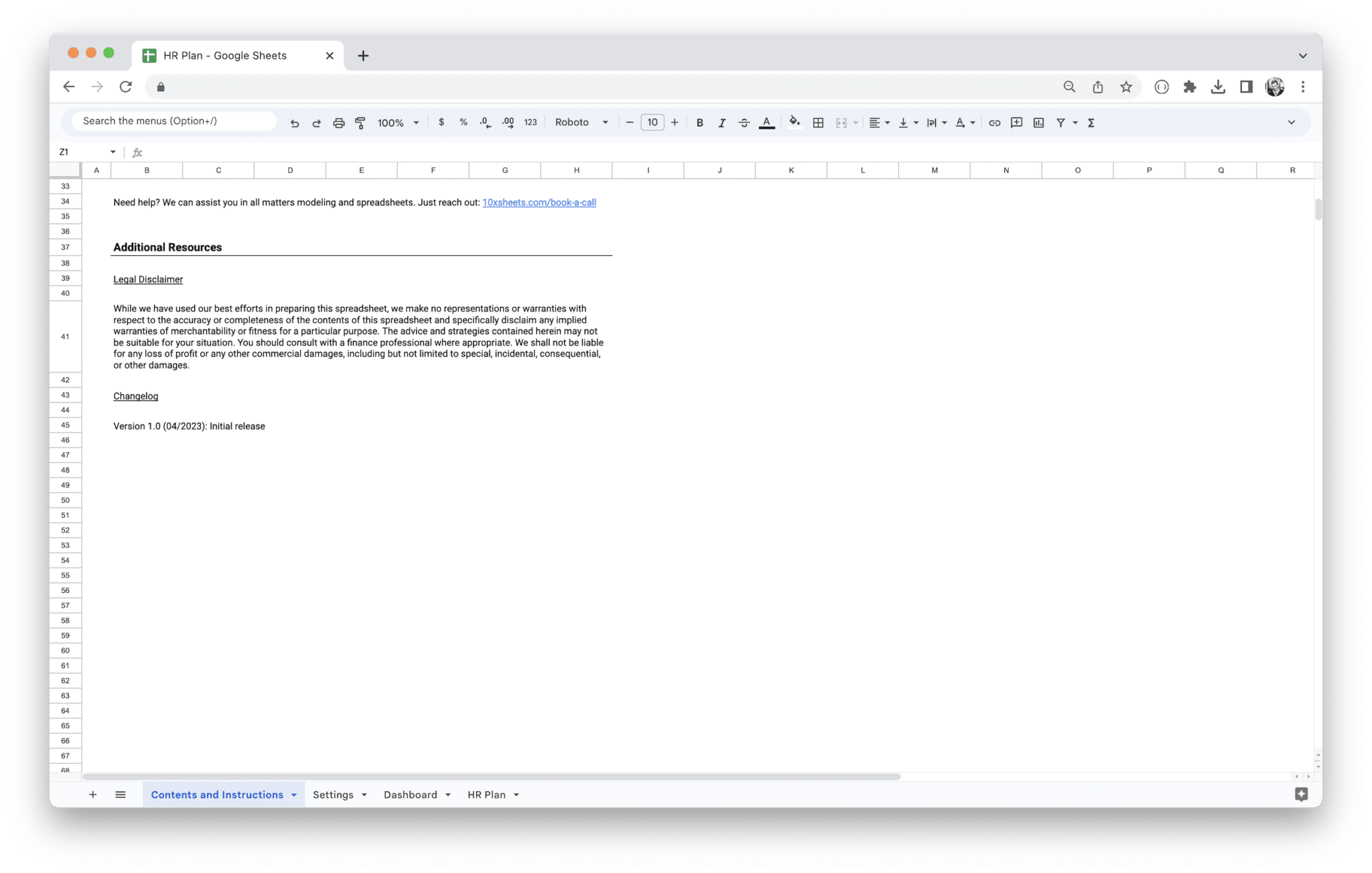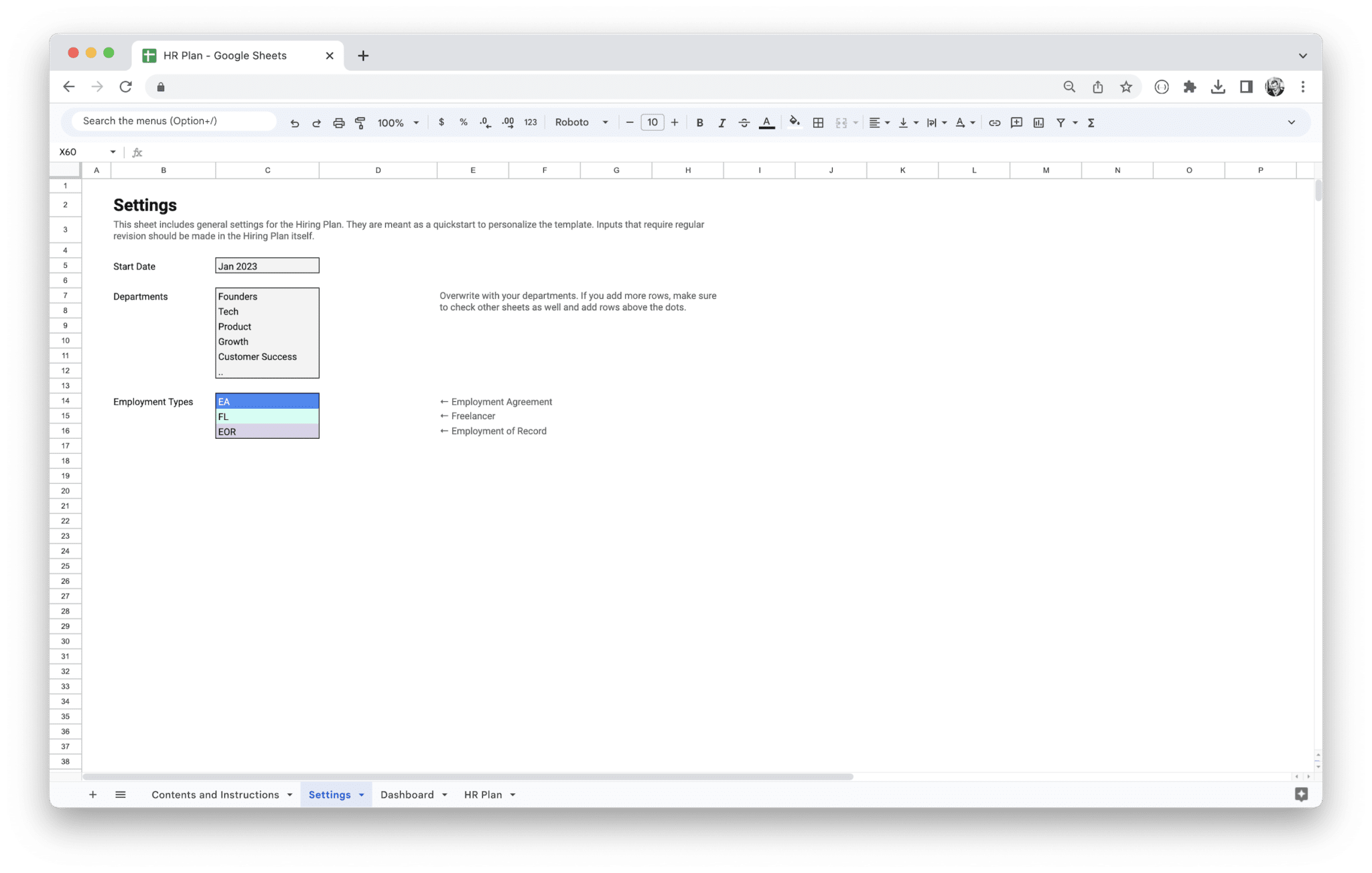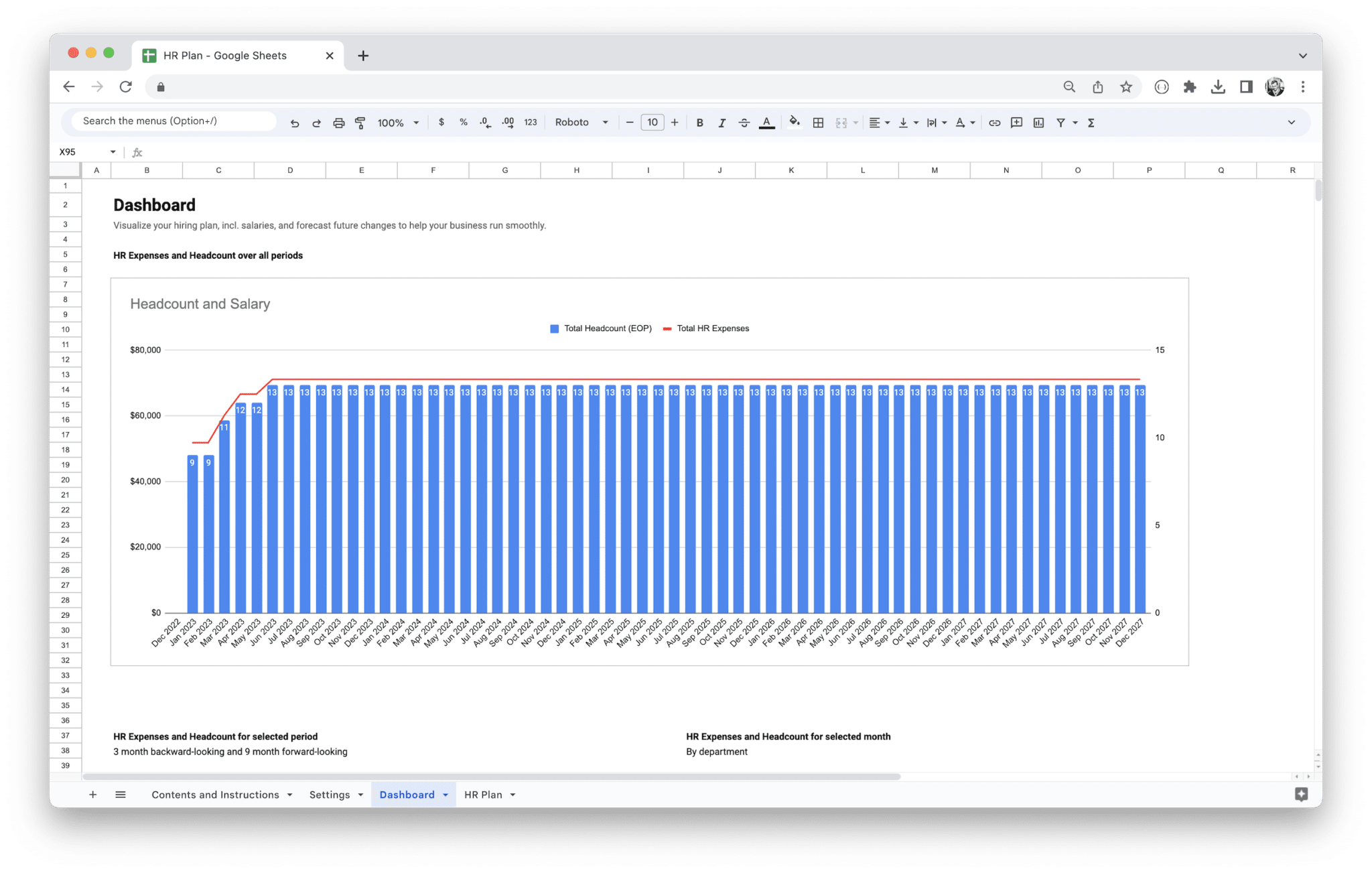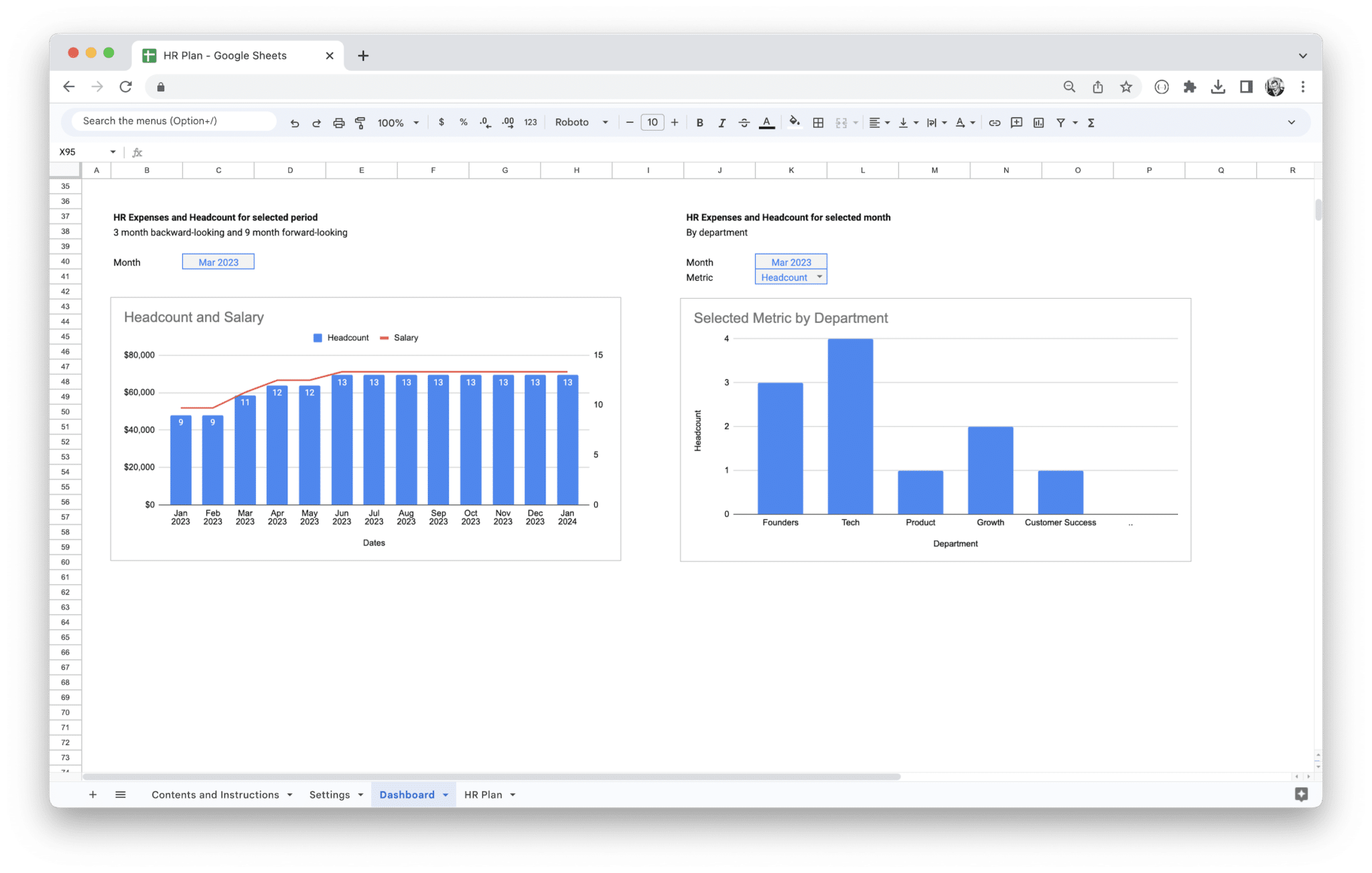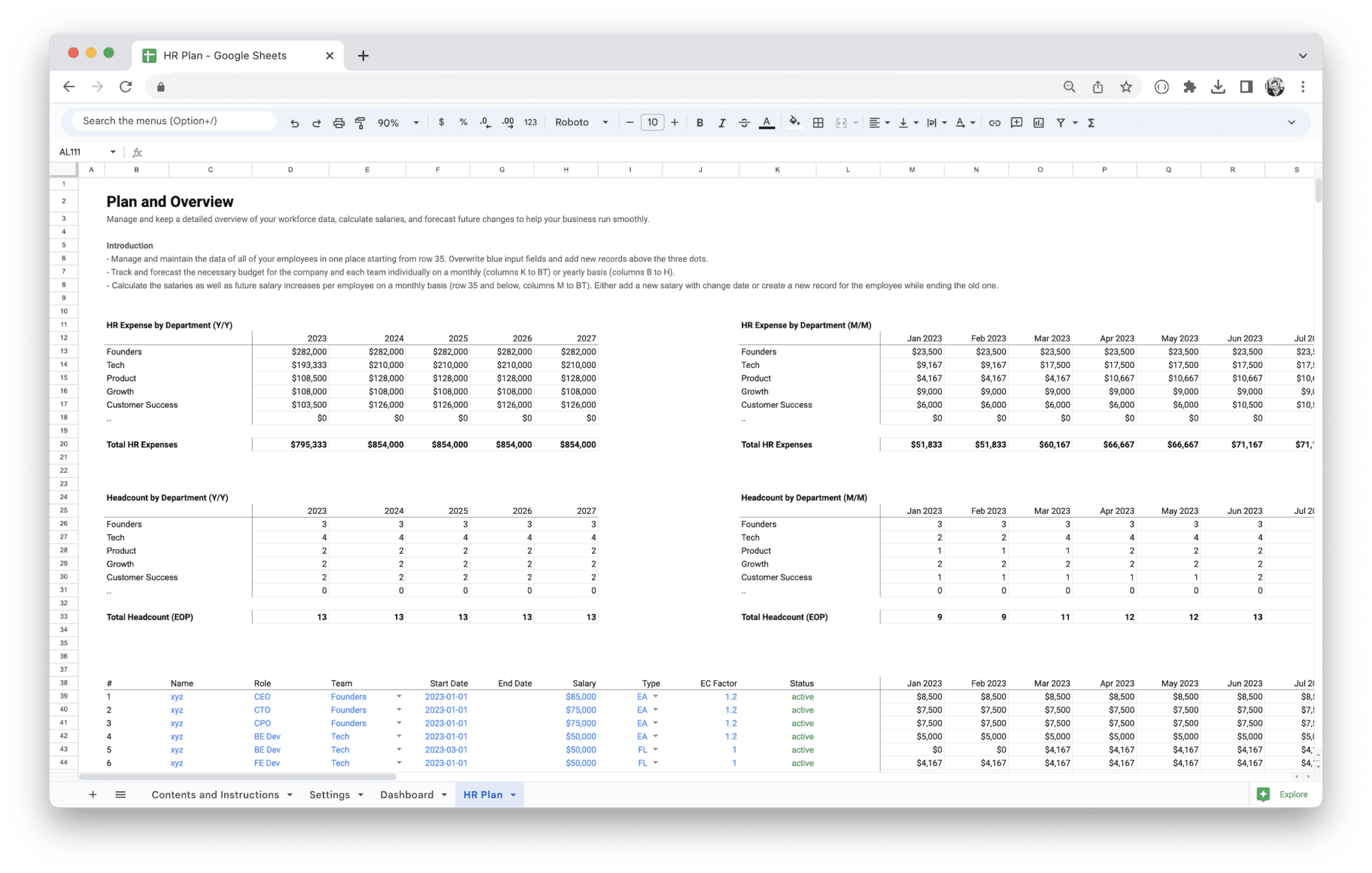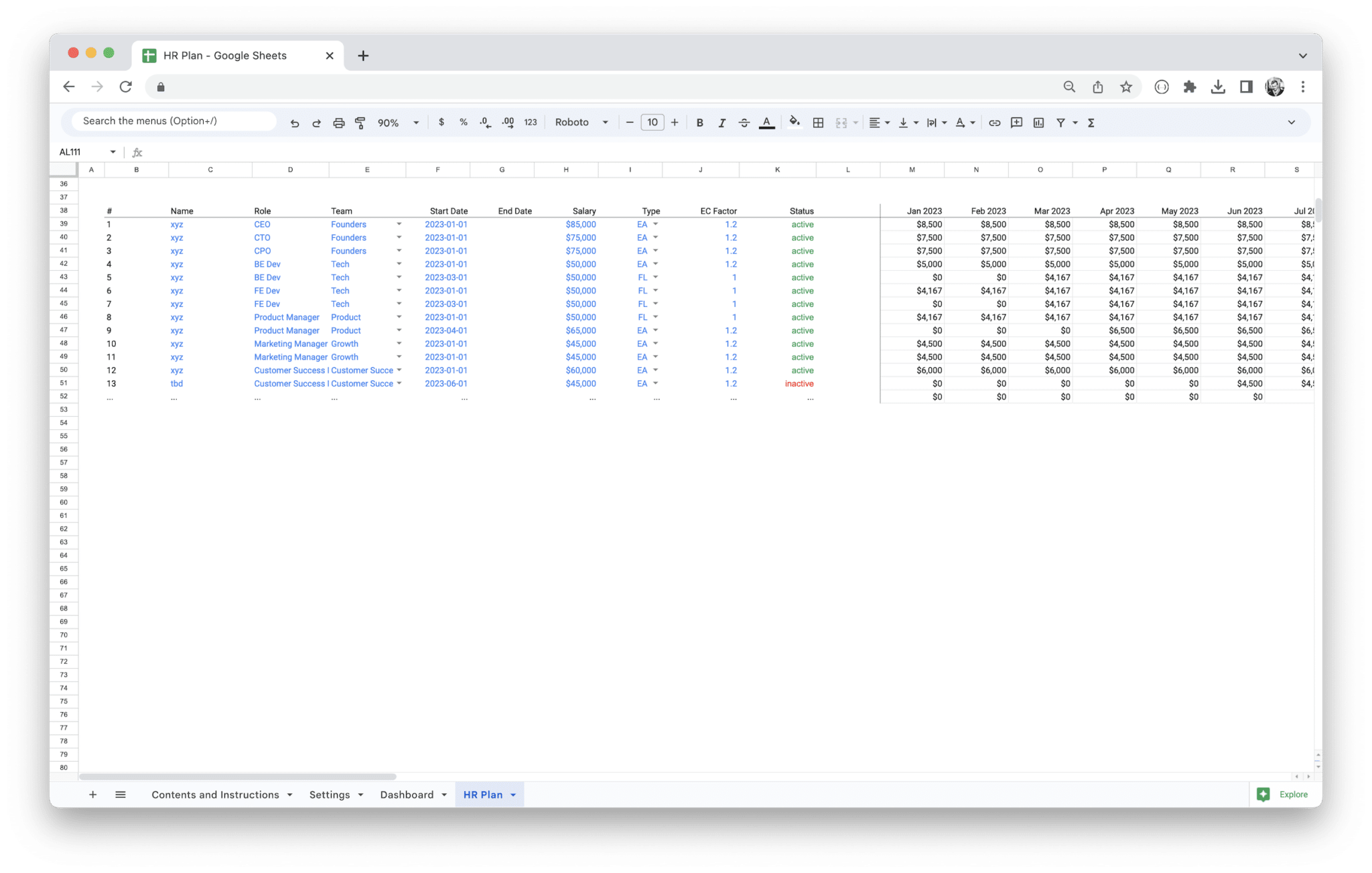Workforce Planning Tool
8,40 €
Value added tax is not collected, as small businesses according to §19 (1) UStG.
Optimize your workforce management with this powerful workforce planning tool. Forecast demand and identify skills gaps to align your workforce with business objectives, streamline processes, and boost productivity.
Description
Managing your workforce effectively can be one of the biggest challenges for any business. Without a clear, data-driven strategy, it’s easy to either overhire, leading to unnecessary costs, or underhire, leaving your team stretched too thin. Striking the right balance is crucial for optimizing productivity and ensuring your business can scale without unnecessary strain. That’s where our Headcount Planning Tool comes in.
This powerful template simplifies workforce planning, helping you forecast staffing needs, allocate resources more efficiently, and align your team with long-term business goals. With features like customizable data input fields, real-time analytics, and scenario planning, you’ll gain a clearer picture of your workforce’s current and future needs. Whether you’re managing growth, reducing turnover, or preparing for market changes, this tool helps you make informed, strategic decisions that drive business success while controlling costs. Take the guesswork out of workforce management and ensure you always have the right people in the right roles, at the right time.
A workforce and headcount planning tool is a software solution or template designed to help businesses manage, forecast, and optimize their workforce. This tool enables organizations to make informed decisions about staffing levels, skill requirements, employee retention, and overall workforce strategy. By leveraging data and predictive analytics, these tools can help companies anticipate staffing needs and align their workforce with their business goals. Workforce planning tools can be particularly useful in industries with fluctuating demand, fast growth, or complex staffing needs.
What is a Workforce Planning Tool?
At its core, a workforce & headcount planning tool helps businesses make better decisions regarding the number of employees they need, the skills required, and when to hire or adjust their workforce. It serves as a blueprint for understanding the current state of the workforce and projecting future needs. This tool aggregates various data points, including employee skill sets, turnover rates, and industry trends, to create accurate forecasts that align staffing levels with business objectives.
By providing a comprehensive view of the workforce, businesses can make proactive, data-driven decisions about recruitment, employee development, and organizational structure. This reduces reliance on gut instinct or reactive strategies, helping businesses stay ahead of the curve as they grow or face changing market conditions.
Importance of Effective Workforce Planning for Business Growth
Effective workforce planning is essential for businesses aiming for long-term success and growth. It enables organizations to be proactive in addressing their staffing needs, which, in turn, supports overall business objectives. Proper workforce planning helps ensure that the right talent is available at the right time, which is crucial in industries where time-to-market or talent availability is critical. Here are some key reasons why workforce planning is so important for business growth:
- Aligns staffing with business goals: By forecasting workforce needs based on business objectives, you can ensure that the right people are in place to meet those goals.
- Optimizes resources: A well-structured workforce plan helps identify and eliminate inefficiencies, ensuring that the right number of people with the right skills are available when needed.
- Drives innovation and agility: Having a clear workforce strategy allows businesses to adapt quickly to changes in market conditions or business priorities.
- Supports talent acquisition and retention: Proper planning helps organizations identify skill gaps and plan for the future, improving recruitment efforts and reducing turnover.
- Improves financial performance: Effective workforce planning ensures that the business operates efficiently and cost-effectively by avoiding overstaffing or understaffing.
By aligning workforce needs with strategic goals, workforce planning ensures that businesses can grow without overextending themselves, creating a sustainable path to success.
How a Workforce Planning Tool Template Can Streamline the Process
A workforce planning tool template simplifies and streamlines the process by providing a framework for managing workforce data, forecasting needs, and analyzing trends. Rather than manually creating spreadsheets or using disconnected systems, a workforce planning tool consolidates all the data into one user-friendly platform. It automates the gathering of key metrics, such as turnover rates, employee performance, and budget requirements, and generates forecasts based on this data.
Using a template offers several advantages. It removes the complexity of workforce planning by providing pre-defined categories and structures, reducing the need for constant updates or reorganization of data. These templates are also highly customizable, meaning they can be tailored to fit the specific needs of any organization. By automating repetitive tasks, such as data entry and reporting, a workforce planning tool template frees up HR and management teams to focus on strategy and decision-making.
The template can also integrate with existing HR systems, such as applicant tracking or payroll systems, ensuring that all workforce-related data is consistent and up-to-date. This leads to better decision-making, greater accuracy in forecasts, and fewer errors in workforce planning. Ultimately, it enables HR teams and leadership to focus on optimizing talent rather than getting bogged down by administrative tasks.
Key Features of an Effective Workforce Planning Tool
An effective workforce planning tool is equipped with features that provide real-time data, predictive analytics, and customizable options to meet the needs of your business. The tool should be intuitive, flexible, and capable of adapting to changing business conditions. Some of the key features that make a workforce planning tool effective include:
- Data Integration: The tool should integrate with other HR systems, such as payroll, applicant tracking, and performance management, to ensure seamless data flow and consistency.
- Customizable Dashboards: Visual dashboards allow users to see key metrics at a glance, enabling quick decision-making and easy monitoring of workforce trends.
- Forecasting Models: Predictive analytics and modeling tools that allow businesses to forecast staffing needs based on historical trends, business growth, and external factors.
- Scenario Planning: The ability to model different scenarios, such as hiring surges or layoffs, to assess their impact on the workforce and develop contingency plans.
- Real-time Analytics: The tool should offer real-time data on headcount, turnover rates, and other key metrics, helping businesses make quick adjustments as needed.
- Reporting Tools: Automated report generation and customizable reporting features that provide actionable insights into workforce performance, recruitment, and financials.
- Skill Gap Analysis: The ability to analyze and identify gaps in employee skills and training needs to ensure the organization has the right capabilities for future business challenges.
With these features, an effective workforce planning tool gives businesses a clear understanding of their current workforce, while also providing the insights necessary to make informed decisions about the future.
Benefits for HR Teams and Leadership
Workforce planning tools are valuable not only for HR teams but also for leadership across the organization. These tools streamline workforce management, reduce errors, and provide data-driven insights that improve decision-making at every level. Here are some key benefits for both HR teams and leadership:
- Improved Strategic Alignment: By aligning workforce planning with overall business goals, both HR and leadership teams can work together to ensure that staffing needs are met while supporting business objectives.
- Enhanced Efficiency: Automation of data entry, reporting, and analysis reduces the time HR teams spend on administrative tasks, allowing them to focus on higher-value activities like recruitment, employee development, and strategic planning.
- Better Decision-Making: With access to real-time data and predictive analytics, leadership teams can make informed decisions about staffing, talent acquisition, and workforce optimization.
- Cost Savings: By accurately forecasting staffing needs and avoiding over- or understaffing, businesses can reduce recruitment and training costs while ensuring operational efficiency.
- Improved Recruitment and Retention: Workforce planning tools allow HR teams to identify potential talent shortages, enabling proactive recruitment efforts. The ability to track and analyze employee turnover also helps organizations implement strategies to improve retention.
- Increased Agility: In a rapidly changing business environment, workforce planning tools give HR teams and leadership the flexibility to adjust quickly to shifts in demand, market conditions, or business strategy.
- Enhanced Employee Experience: By aligning staffing levels with organizational goals, companies can create a better work environment where employees are supported, workloads are balanced, and opportunities for development are clear.
In summary, workforce planning tools offer HR teams and leadership a comprehensive view of their workforce, allowing for more strategic, informed, and effective management of talent. The benefits extend far beyond staffing decisions—they support overall business growth and ensure that a company’s workforce is aligned with both current and future needs.
A workforce and headcount planning tool is only as effective as the components it contains. Whether you’re managing a small team or an entire global workforce, the right template will help you forecast, track, and optimize your staffing needs. Let’s dive into the key components that make up an effective workforce planning tool template.
Data Input Fields and Customizable Options
One of the most important features of any workforce planning tool is its ability to capture and process relevant data. The data input fields are the foundation of the tool, so they must be tailored to your company’s specific needs. A well-designed template will offer customizable options to allow you to capture all relevant data points. This flexibility is key because each organization has different staffing requirements, depending on its size, industry, and operational complexity.
The data input fields typically include basic employee information such as name, department, role, and location, but a robust template will go much deeper. For example, it should allow you to track:
- Employee Skill Sets: Categorize employees by their skills, certifications, and competencies to identify any gaps that may exist within your team.
- Workforce Demographics: Information such as age, tenure, and career development plans can help you predict turnover rates and plan for succession.
- Employee Performance Metrics: Capture performance reviews, goals, and productivity metrics that can help align workforce planning with performance management.
- Time Allocation: Track the amount of time employees are spending on specific projects or tasks, allowing for better allocation of resources.
Customizable options within the tool are essential because every business has unique workforce demands. For instance, a technology company may want to focus heavily on the skill sets of its engineering team, while a retail business may prioritize tracking store-specific staffing levels. The ability to adjust input fields ensures the template works well for your organization’s particular needs.
Forecasting Models and Scenario Planning
Forecasting is one of the most powerful functions of any workforce planning tool. It allows you to project future headcount requirements based on various factors, such as business growth, market demand, or even external economic conditions. With an effective forecasting model, you can anticipate staffing needs and budget accordingly, making sure you’re ready for any scenario.
Forecasting models use historical data, industry trends, and business projections to predict future staffing requirements. The tool will typically allow you to input assumptions about business growth, employee turnover, and external factors (e.g., economic downturns, new regulations, or market trends). These assumptions will then feed into the model, generating forecasts for future hiring, retention, and layoffs.
Scenario planning is closely tied to forecasting. It allows you to explore different possibilities and prepare for various business conditions. For example, you might want to test the impact of launching a new product line or expanding into a new market on your staffing requirements. By running different scenarios, you can prepare for potential workforce shifts and adjust your hiring strategy accordingly.
The power of forecasting and scenario planning lies in its ability to provide data-driven insights into your workforce needs. It can tell you things like:
- How many employees you will need to hire in the next 12 months.
- Which departments are likely to face staff shortages or surpluses.
- The optimal headcount required to meet business growth targets without overextending your resources.
By accurately predicting staffing needs, you can avoid being caught off guard by sudden talent shortages or surpluses, which can lead to costly and inefficient operations.
Tracking and Reporting Capabilities
A workforce planning tool is not just about predicting future needs; it’s also about tracking and analyzing your workforce in real-time. The tracking and reporting capabilities within a workforce planning tool are crucial for understanding whether your current workforce is aligned with your business goals.
Tracking involves monitoring key workforce metrics such as headcount, turnover rates, employee performance, and budget utilization. These metrics should be updated in real-time to provide accurate data at any given moment. With tracking features, you can monitor your workforce’s status continuously and make adjustments to your plans when necessary.
Reporting features go hand-in-hand with tracking. They allow you to generate reports that provide a deeper understanding of your workforce data. Reports can be used to summarize key metrics, compare actual performance to forecasts, and highlight areas that need attention. A strong reporting feature in a workforce planning tool will include:
- Customizable Dashboards: These dashboards allow you to view workforce data in a visual format, making it easier to analyze trends, patterns, and anomalies.
- Forecast vs. Actual Reports: These reports compare your projected workforce needs to the actual data, helping you understand how accurate your forecasts have been and where adjustments are needed.
- Turnover Reports: These reports give you insight into employee turnover rates, helping you identify patterns and trends that might indicate areas for improvement in your retention strategies.
With the ability to track and report on workforce metrics, you can make data-driven decisions to optimize your staffing levels and avoid both under- and over-staffing. Reports also enable you to present workforce data to stakeholders in a format that is easy to understand, whether that’s HR leaders, finance teams, or senior management.
Integration with Other HR Software and Tools
One of the biggest advantages of using a workforce planning tool template is its ability to integrate with other HR software and tools. These integrations enable seamless data flow between systems, reducing manual data entry and ensuring that all of your workforce-related data is accurate and up-to-date.
Integration with Applicant Tracking Systems (ATS), for example, allows you to pull data directly from your recruitment software into the workforce planning tool. This means you can automatically update your headcount forecasts based on new hires or position changes, without having to manually enter this information.
Likewise, integration with payroll systems ensures that your headcount projections align with your compensation data, helping you manage labor costs more effectively. These integrations allow the tool to track changes in headcount and employee compensation in real-time, providing a more accurate picture of your workforce costs.
Another important integration is with performance management systems, which can provide valuable data on employee performance and development needs. By integrating this data into your workforce planning tool, you can better understand your team’s capabilities and make more informed decisions about promotions, training needs, and succession planning.
The ability to integrate with other systems also makes your workforce planning tool more scalable. As your business grows and adds more HR tools, you can continue to connect them with your planning tool to ensure that all of your workforce data is consistent and centralized.
These integrations improve the efficiency and accuracy of your workforce planning efforts, allowing you to manage your talent pool in a more organized and streamlined way.
Workforce and headcount planning may not always be at the top of every business agenda, but it is one of the most important factors in achieving long-term success. Whether you’re scaling up your team, managing turnover, or expanding into new markets, having a well-thought-out workforce strategy can significantly impact your company’s performance, culture, and financial health. Let’s dive into why workforce and headcount planning is so crucial and how it can support business growth.
Aligning Workforce with Business Goals
Your workforce is the engine that drives your business. However, no matter how skilled and capable your team is, if their efforts aren’t aligned with your business goals, the organization will not reach its full potential. Workforce planning ensures that your staffing levels, roles, and skills are optimized to meet the strategic objectives of the company.
For example, if your business is planning to enter a new market or launch a new product, workforce planning helps you prepare by ensuring you have the right mix of talent to support these initiatives. You can forecast the number of employees needed in specific departments, such as marketing, product development, or customer service, and hire accordingly.
Proper alignment between your workforce and business goals also helps streamline operations and prevent inefficiencies. When you align your staffing levels with the goals of the company, you’re able to ensure that every department and every individual is contributing to the overall vision. You can avoid situations where some teams are overstaffed while others are understaffed, which leads to wasted resources, missed opportunities, or burnout among employees.
It’s not just about hiring more people or assigning roles; it’s about ensuring the right people are in the right places, and that their talents are being leveraged to meet the specific needs of the business. This alignment increases productivity, supports innovation, and enhances the overall effectiveness of the workforce.
Cost Savings and Efficiency Improvements
When done correctly, workforce planning can lead to significant cost savings and improvements in operational efficiency. For most businesses, labor costs are one of the highest expenses, and without a strategic approach to workforce planning, it’s easy to either overestimate or underestimate staffing needs, which can have a detrimental effect on both the bottom line and employee morale.
By forecasting staffing needs and aligning them with business objectives, workforce planning enables you to better manage labor costs and avoid unnecessary expenses. For example, if you know you’ll need extra support during peak seasons, you can plan ahead to hire temporary staff or adjust workloads, rather than scrambling to find employees at the last minute. On the flip side, if you’re experiencing a slowdown in business, you can proactively adjust your workforce by offering cross-training to reduce layoffs or overstaffing.
Another aspect of cost savings comes from minimizing turnover. High turnover rates are costly in terms of recruitment, training, and lost productivity. Effective workforce planning helps anticipate turnover trends, enabling businesses to put in place strategies to retain their best talent. By understanding where you might be losing employees—whether due to compensation issues, lack of career development, or burnout—you can take steps to address those factors before they result in high turnover.
Furthermore, workforce planning can improve efficiency by ensuring that the right employees are available at the right time, reducing downtime and bottlenecks. The ability to forecast future needs based on historical data and market trends allows businesses to stay agile, quickly responding to changing conditions while maintaining a smooth operation.
Anticipating Future Staffing Needs and Trends
One of the most powerful aspects of workforce planning is its ability to anticipate future staffing needs and trends. In today’s fast-paced business world, the ability to predict future challenges and prepare for them is a key driver of success. Workforce planning helps you avoid being caught off guard by sudden changes in business conditions or market demand.
For instance, if your company is growing rapidly or planning a major expansion, workforce planning enables you to predict the headcount required to support that growth. By understanding the staffing needs of each department, you can hire, onboard, and train employees in advance, ensuring that you’re ready to scale without delays. Additionally, you can forecast skill gaps that might emerge as the company grows, allowing you to recruit employees with the skills and expertise needed to meet future challenges.
Market trends and external factors also play a significant role in workforce planning. For example, a business in the tech sector may need to anticipate shifts in technology or industry standards that could require new skill sets or the hiring of specialized talent. On the other hand, businesses in industries like retail or hospitality may need to adjust their workforce based on seasonal demand fluctuations.
Another critical element in forecasting staffing needs is understanding internal factors such as employee career paths, maternity leave, or planned retirements. By knowing when employees are likely to leave, retire, or move to different roles within the company, you can plan ahead to fill these gaps and minimize disruptions.
Workforce planning is not just about reacting to the current state of affairs, but also preparing for future challenges. By staying ahead of trends, businesses can maintain their competitive edge, mitigate risk, and ensure they are prepared for whatever the future holds.
Supporting Talent Acquisition and Retention Strategies
Effective workforce planning doesn’t just focus on your current employees; it also helps shape your talent acquisition and retention strategies. A strong workforce plan allows you to identify potential gaps in your team, both in terms of numbers and skill sets, and take proactive steps to address them through targeted recruitment or internal development programs.
By anticipating your future staffing needs, you can work with your recruitment teams to develop a pipeline of candidates well in advance, rather than scrambling to fill positions at the last minute. For example, if you know you will need a certain number of software developers in the coming months, you can begin to build a talent pool and foster relationships with candidates ahead of time, reducing the time-to-hire and improving the quality of your hires.
Workforce planning also plays a critical role in retention strategies. When you know where potential skills gaps or turnover risks exist within your organization, you can implement targeted programs to address those areas. Whether it’s offering professional development opportunities, cross-training employees, improving work-life balance, or adjusting compensation, workforce planning provides the data and insights needed to create an environment where your employees are more likely to stay long-term.
Moreover, workforce planning helps you identify high-potential employees who may be suitable for leadership roles or other strategic positions. By mapping out clear career progression paths, you can ensure that your employees feel valued and have opportunities for growth, which enhances job satisfaction and loyalty.
In addition, retaining top talent is not just about salary; it’s about offering an environment where employees can thrive. When you align your workforce strategy with the long-term goals of your business, you create a culture of mutual growth and success, making it more likely that your top performers will stay with the company and continue to contribute meaningfully to its success.
Utilizing a workforce and headcount planning tool template can seem daunting at first, but once you break down the process and follow a clear strategy, it becomes a valuable asset that will streamline your planning efforts and help you make data-driven decisions. Let’s walk through how to effectively use a workforce planning tool template, from initial setup to ongoing customization and analysis.
Setting Up the Template
Setting up your workforce planning tool template starts with organizing the data you’ll need and configuring it in a way that serves your company’s specific requirements. Here’s a step-by-step breakdown to ensure you get the most out of the tool.
The first thing to do is gather your existing workforce data. This includes employee details like job titles, departments, salary, work schedules, skill sets, and performance history. Having accurate and up-to-date data ensures that your planning tool will function correctly from the start.
Once you have the data, define the planning horizon. Are you forecasting staffing needs for the next quarter, year, or longer? The horizon will influence the kind of data you input and the level of granularity required in your projections. For instance, if you’re planning for an upcoming project, the forecast will be much more detailed than if you’re planning for overall organizational growth in the next five years.
Next, input the data into the template. Many workforce planning tools are designed to be user-friendly and come with customizable fields for various data points. You can enter basic information like employee headcount, role distribution, and team sizes, but a more advanced template will also allow you to add details about skills, turnover rates, and future recruitment needs.
Configure the forecasting model based on your business strategy. Will you be using historical trends, market growth predictions, or a combination of both to forecast headcount needs? This step is crucial as it drives how your workforce planning tool will calculate the number of employees needed and the skills they must have. Some templates offer scenario-planning features, so you can test different staffing levels under different business conditions, like a market slowdown or an expansion.
Once your data is in place, set up reporting and tracking features. These allow you to monitor how well your workforce is aligned with your business goals and assess whether any adjustments are needed in real time. Reports can help track key metrics like headcount, turnover rates, and hiring progress.
Customizing the Tool for Specific Business Needs
No two businesses are identical, and your workforce planning tool needs to reflect that. A good template will be flexible enough to adapt to your specific business model, size, and industry. Customization is where you can tailor the tool to address your company’s unique challenges.
Start by adjusting the input fields to fit the structure of your organization. For example, if your business operates in multiple regions or countries, you may want to include location-based fields to track headcount by office or region. For a company with a large number of departments or complex project teams, adding specific divisions or team-based fields could give you more granular control over planning.
The forecasting model should also be customized to reflect your company’s goals. For example, a tech company looking to hire more software engineers might want to input a detailed projection of the engineering team’s growth, based on projected product launches or development milestones. In contrast, a retail company might be more focused on forecasting based on seasonal demand or store openings.
Don’t forget to customize job roles and skill categories. You’ll need to ensure that your workforce planning tool includes a comprehensive list of the roles critical to your company. Also, identify which skills are most important for each role. For instance, a project management role may require skills in Agile methodologies, while a marketing position may prioritize skills in SEO or digital advertising. This customization helps you anticipate potential skills gaps and build a more capable workforce.
Finally, integrate the tool with other systems where possible. Many workforce planning tools integrate with HR management systems, payroll software, or applicant tracking systems (ATS). By linking the workforce planning tool with these systems, you ensure that your workforce data is synchronized and that forecasts are based on the most up-to-date and accurate information available.
Best Practices for Data Entry and Updating the Template
Data is the lifeblood of workforce planning, and keeping it accurate and current is key to ensuring the success of your planning efforts. While data entry can sometimes seem tedious, following best practices will streamline the process and make your workforce planning more effective.
One of the most important best practices is to ensure consistency in the way you input data. For example, if you are tracking employee skills or performance metrics, make sure you use the same criteria for each person. Consistency will make it easier to analyze data across teams or departments and ensure that your forecasting models are based on uniform assumptions.
Use standardized job titles and descriptions. This makes it easier to categorize roles across the company and ensures that forecasting models are more accurate. When everyone uses the same terminology, you can more easily track trends in hiring and promotions, as well as identify gaps in your workforce.
Another best practice is to regularly update your workforce data. Staffing needs can change quickly, so you need to continuously update the tool with the latest information. For instance, if an employee is promoted or leaves, make sure their data is updated in the tool. Similarly, if you bring on new hires or adjust compensation structures, update those details as well. Set a reminder to review and update the workforce planning tool on a regular schedule, whether it’s monthly, quarterly, or after significant company events.
Don’t forget to back up your data. While most workforce planning tools are cloud-based and offer automatic data storage, it’s always a good idea to manually back up important data. This helps prevent data loss in the event of system errors or unexpected issues.
Tips for Forecasting and Analyzing Headcount Trends
Forecasting headcount trends accurately is one of the most valuable capabilities of a workforce planning tool. Getting it right helps businesses avoid over- or under-staffing, both of which can be costly. To make the most of your forecasting capabilities, you need to approach it with careful analysis and attention to key metrics.
Start by reviewing historical data to identify trends. Past headcount data, turnover rates, and business growth patterns can offer valuable insights into your future staffing needs. For example, if your business has historically grown at a rate of 10% annually, you can use that information to project future growth and plan headcount accordingly. If you anticipate hiring to accommodate new clients or products, this historical data will help validate your assumptions.
When forecasting, remember that business cycles and external factors play a significant role in headcount planning. For instance, economic shifts, industry disruptions, or changes in government regulations can dramatically impact your workforce needs. Make sure to incorporate factors like these into your forecasts. For example, if you’re in a seasonal industry, forecasting tools should be adjusted to account for peak times where additional temporary staff may be required.
Use scenario planning to account for uncertainty. Scenario planning lets you test different assumptions and see how they might affect your workforce. For example, you might test how your headcount needs would change if your company experienced a 10% increase in sales or if a key employee group left. By modeling multiple scenarios, you can better prepare for different outcomes and develop strategies to handle potential challenges.
Analyzing headcount trends is equally important. Keep a close eye on metrics such as turnover rates, employee performance, and time-to-hire. If turnover is higher than expected, this could indicate that you need to adjust your retention strategies. Similarly, if you’re taking longer to hire the right talent, you may need to reassess your recruitment strategy. Analyzing these trends over time helps you spot issues early, so you can take corrective action before they become bigger problems.
Finally, always validate your forecasts and assumptions. It’s important to revisit your headcount projections regularly to see if they are accurate. Track actual headcount numbers against your forecasts and adjust your plans as needed. By reviewing and updating your forecasts periodically, you ensure that your workforce planning tool stays relevant and continues to support your company’s growth effectively.
To make your workforce and headcount planning efforts as effective as possible, it’s important to follow some tried-and-true best practices. By adhering to these guidelines, you can ensure that your planning tool works efficiently, aligns with your business goals, and helps you optimize your workforce strategy.
- Regularly Update Your Workforce Data: Your workforce planning tool is only as good as the data it holds. Make it a priority to update your workforce data regularly, especially when there are changes in headcount, employee roles, or performance. This ensures your forecasts are accurate and aligned with your actual needs.
- Focus on Strategic Alignment: Make sure that your workforce planning aligns with the long-term goals of the company. Every hiring decision and staffing projection should support the broader business strategy. Whether you’re expanding into new markets or launching a new product, your workforce plan should reflect and support those objectives.
- Incorporate Flexible Forecasting Models: Instead of relying on one fixed forecast, build flexibility into your planning process. Use models that can adapt to varying market conditions, economic changes, and company growth. This allows you to quickly adjust your staffing plans and be prepared for both positive and negative changes.
- Utilize Scenario Planning: Never assume that your forecasts will remain static. Utilize scenario planning tools to test various assumptions and outcomes, such as growth, layoffs, or shifts in demand. This helps you prepare for the unexpected and stay agile in the face of change.
- Monitor Key Performance Metrics: Track important workforce metrics, such as turnover rates, hiring velocity, and employee engagement, regularly. Monitoring these metrics will give you valuable insights into the effectiveness of your workforce planning and help identify areas that may require adjustment.
- Collaborate Across Teams: Workforce planning is a team effort. Engage not only your HR department but also finance, operations, and leadership teams to ensure that everyone is aligned and contributing to the plan. This cross-departmental collaboration ensures that your workforce strategy is aligned with company-wide goals and challenges.
- Incorporate Employee Development and Retention Strategies: A good workforce plan doesn’t just focus on hiring. It should also include strategies for retaining top talent and developing employees for future roles. Consider succession planning, training opportunities, and career progression as part of your overall workforce strategy.
- Leverage Technology to Streamline the Process: Take full advantage of the technology and automation features available within your workforce planning tool. Automating data entry, updates, and reporting will save time and reduce errors. Technology can also help you track trends and generate insights that might otherwise go unnoticed.
- Stay Informed About Industry Trends: Keep a pulse on the market and industry trends that could impact your workforce needs. Economic shifts, technological innovations, and changing labor laws can all affect staffing strategies, so staying informed will help you plan more effectively and stay ahead of the curve.
- Ensure Data Consistency and Accuracy: Consistency is key when inputting data into your workforce planning tool. Be sure that job titles, performance metrics, skill sets, and other important data points are entered in a standardized way to ensure accurate forecasts and meaningful reports.
- Set Regular Review Periods: Workforce planning is not a one-time effort. Set regular review periods to assess the success of your workforce strategy, adjust for any changes, and make improvements. A quarterly or biannual review cycle can ensure that your workforce planning remains relevant and effective in supporting the company’s evolving needs.
Implementing a workforce and headcount planning tool can be a game changer for your business, but there are some common mistakes that can undermine its effectiveness. Even with the best tools at your disposal, you might still encounter issues if certain practices aren’t followed. Understanding these pitfalls and how to avoid them will ensure that you’re making the most out of your workforce planning tool.
- Overcomplicating the Setup: Trying to track too many variables or overly complicating the setup with unnecessary data points can create confusion and reduce the tool’s effectiveness. It’s important to keep the system user-friendly and tailored to your specific business needs without making it overly complex. Focus on the most impactful data that will drive your decisions rather than overwhelming yourself with extraneous details.
- Relying on Outdated Data: The power of a workforce planning tool lies in the accuracy and timeliness of the data entered. Relying on outdated or incomplete data leads to poor forecasts and inaccurate staffing predictions. Regularly update your data and ensure that it’s always reflecting the most current information about your workforce.
- Neglecting Scenario Planning: A common mistake is failing to anticipate different scenarios and not planning for fluctuations in demand, market shifts, or other variables. If your workforce planning tool doesn’t incorporate multiple scenarios, you might be caught off guard when unexpected changes happen. Make sure to regularly run “what-if” scenarios to prepare for future challenges.
- Not Involving Key Stakeholders: Workforce planning is a collaborative effort that should involve HR, finance, and leadership teams. A siloed approach can lead to gaps in strategy and missed opportunities. Make sure that all relevant stakeholders are engaged in the process so that the plan is aligned with broader business goals.
- Ignoring Employee Development Needs: Many workforce planning tools focus primarily on headcount projections and hiring, but it’s also essential to consider employee development. If you’re only focused on filling immediate roles without taking into account training, career progression, and skill development, you risk missing out on long-term growth opportunities.
- Underestimating the Impact of External Factors: Workforce planning doesn’t exist in a vacuum—economic shifts, technological changes, and industry trends all affect staffing needs. A workforce planning tool that doesn’t take these external factors into account will lead to unrealistic forecasts. Be mindful of how market conditions, regulation changes, and other external elements can impact your workforce strategy.
- Lack of Regular Monitoring and Updates: Workforce planning isn’t a one-time task. If you only update your plan once a year or fail to monitor it frequently, you’re missing out on key insights that could impact your hiring and staffing decisions. Make it a habit to revisit your workforce plan regularly and update it based on new data, business changes, or external factors.
- Failing to Utilize Reporting Features: A workforce planning tool is only as good as the insights you derive from it. Many businesses fail to fully utilize the reporting and analytics features, which are essential for tracking progress and identifying areas that need improvement. Don’t just enter data—make sure to analyze it, track key metrics, and use the reports to inform your decision-making process.
Make a one-time payment and
enjoy your template forever.
No extra costs, no strings attached,
more savings for you.
Keep your templates up-to-date
with free access to regular updates.
Related products
-
Sale!


SaaS Financial Model Template
184,03 €Original price was: 184,03 €.125,21 €Current price is: 125,21 €.Value added tax is not collected, as small businesses according to §19 (1) UStG.
Add to cart Details -
Sale!


Startup Financial Model Template
100,00 €Original price was: 100,00 €.66,39 €Current price is: 66,39 €.Value added tax is not collected, as small businesses according to §19 (1) UStG.
Add to cart Details -
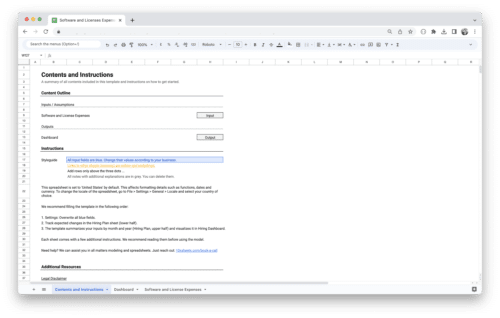
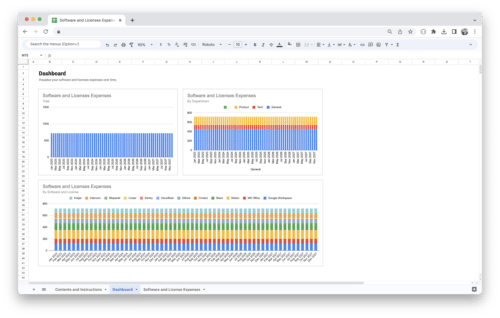
Value added tax is not collected, as small businesses according to §19 (1) UStG.
Add to cart Details -
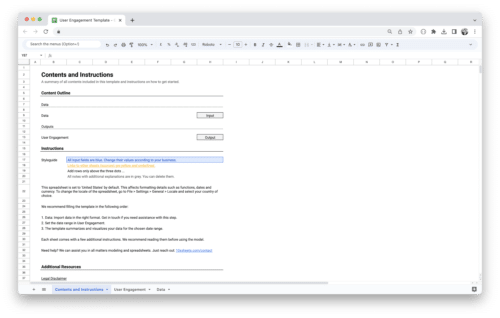
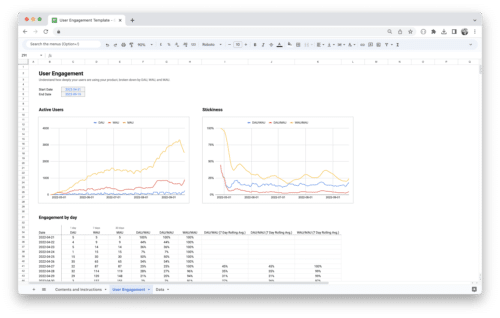
Value added tax is not collected, as small businesses according to §19 (1) UStG.
Add to cart Details

